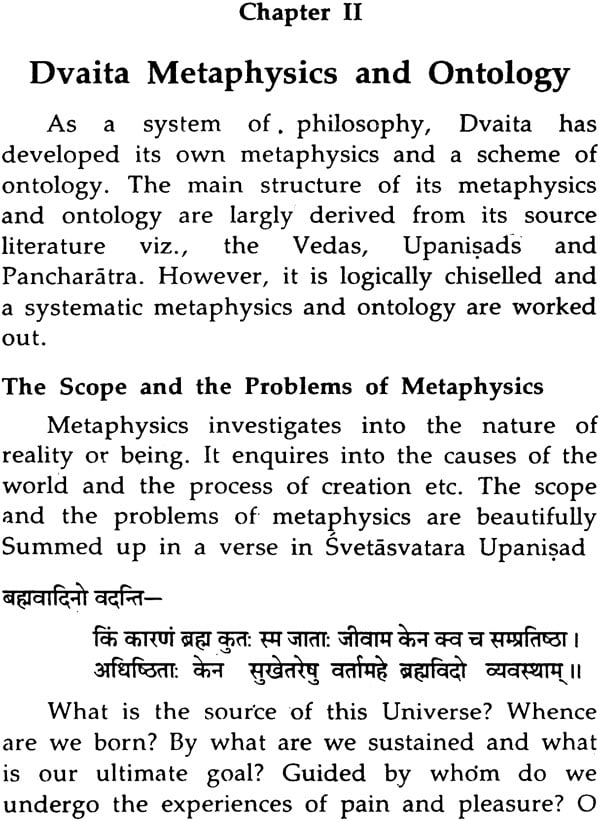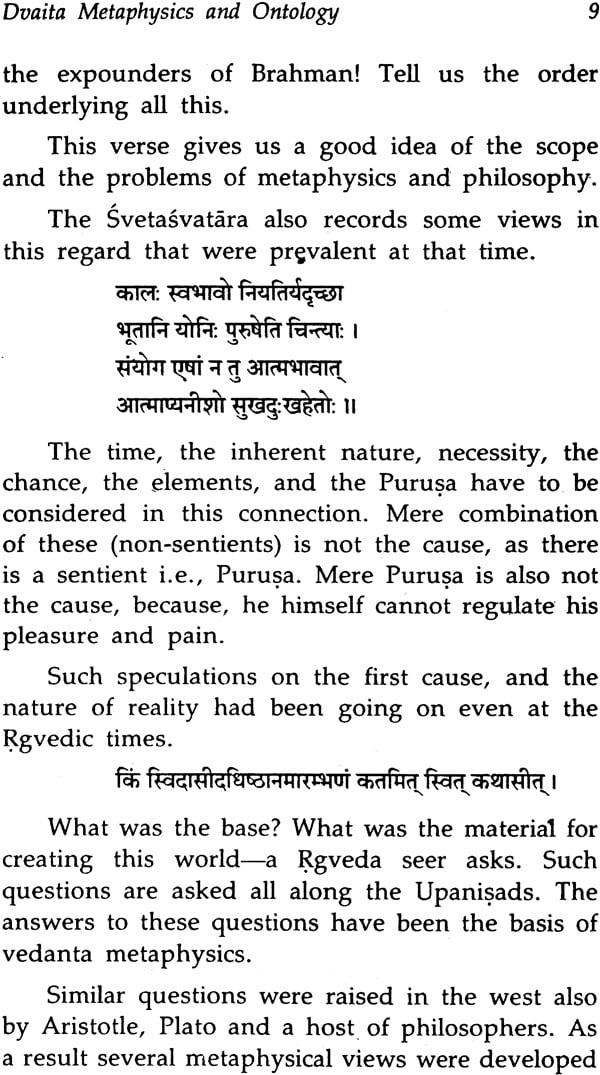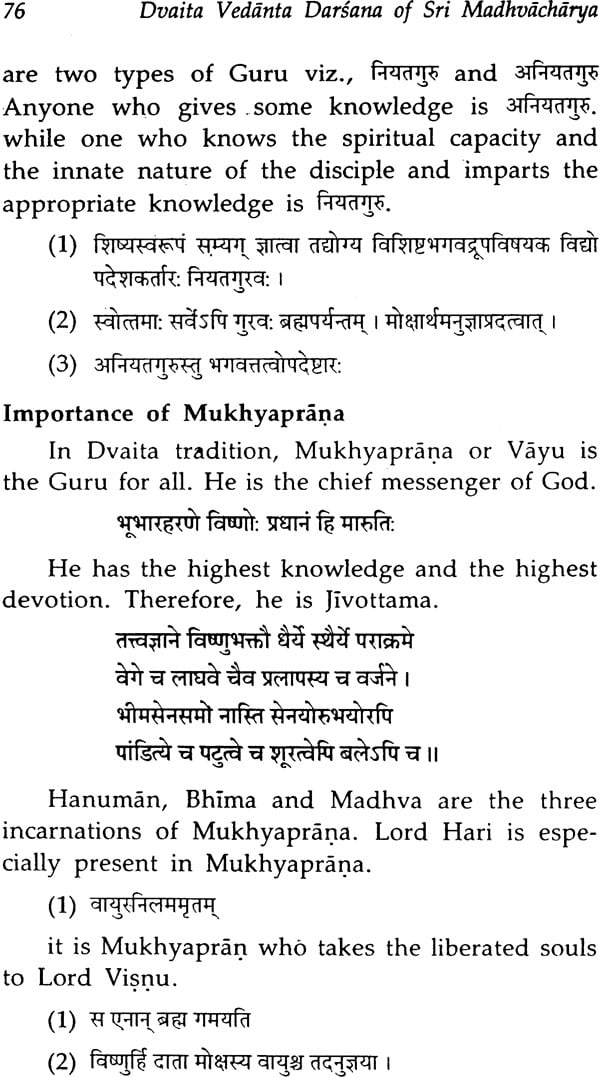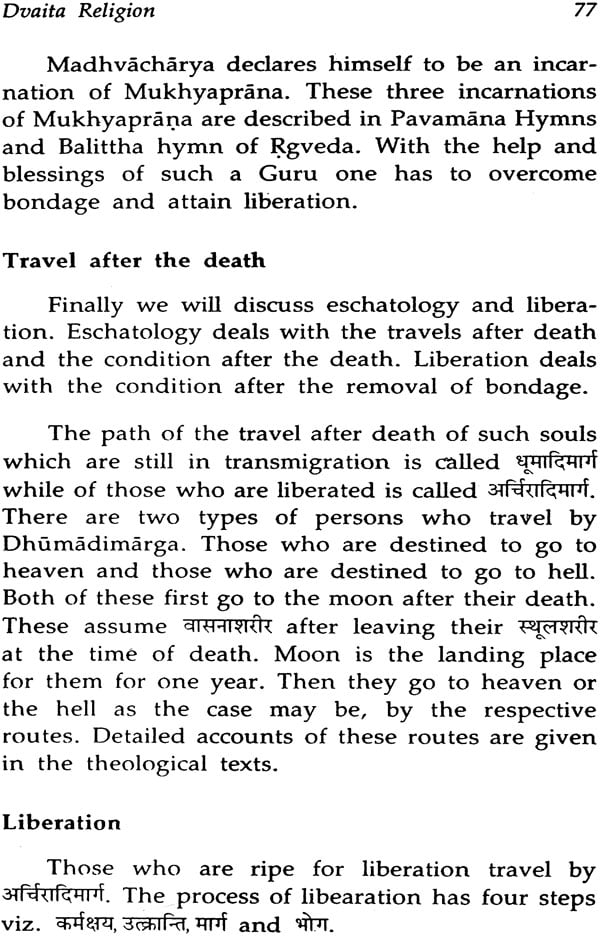
Dvaita Vedanta Darsana of Sri Madhvacharya
Book Specification
| Item Code: | NAF173 |
| Author: | K.T. Pandurangi |
| Publisher: | Rashtriya Sanskrit Sansthan, Janakpuri |
| Language: | Sasnskrit Text With English Translation |
| Edition: | 2012 |
| ISBN: | 9789382091059 |
| Pages: | 84 |
| Cover: | Hardcover |
| Other Details | 9.0 inch X 6.0 inch |
| Weight | 250 gm |
Book Description
This book deals with Dvaita Vedanta Philisophy of Shri Madhvacharya, an important school of Vedanta philosophy. The learned author has critically analysed and propounded various concepts like metaphysics, ontology, epistemology, ethics, religion etc, according to Dvaita principle.
Krishnacharya Tammannachaiya Pandurangi was born on 1st Dec. 1918 in Tumminakatti village of Dharwad District in Karnatak. He received his education in Sanskrit literature, Nyaya, Vedanta and Mimansa in the traditional way and obtained the titles of Vidwan and Siromani in these Sastras. Later he graduated and obtained the M.A. Degree.
He served as Lecturer and Reader for two decades and joined Bangalore University as Head of the Dept. of Sanskrit in 1968 and retired in 1979.
He has contributed many significant works on different franches of Sanskrit learning including “The Wealth of Sanskrita Manscripts in India and abroad.” Nvayamrtam with Advaita Siddhi and three other commentaries, Sarvamulagranthas of Madhv-acharya, Brahmasütra Anuvyakhvana translation of ten Principal Upanisads into English according to Madhvabhasya, translation of Visnutattvanirnaya into English Ravindra Rupakani and Kavyanjali. He received Rastrapti award in 1989. He has been Upakulapati of PoornaprajñaVidya Pitha Banglore.
I have great pleasure to present this volume of Silver Jubilee Publication Series of the Rashtriya Sanskrit Sansthan to our esteemed readers. The Volume varily represents the goodwill and cooperation, the Sansthan has all along been receiving from the distinguished scholars all over the country.
The Sansthan was established in October, 1970 as an autonomous apex body under the Ministry of Human Resource Development, Govt. of India with a view to promoting, preserving and propagating Sanskrit learning in all its aspects, with special reference to the indepth shastraic learning. Apart from conducting the regular courses of studies at the various constituent Vidyapethas, it has been bringing out invaluable publications representing dissemination of knowledge contained in the ancient Shastras. With the continued help, encouragement and support from the Ministry of Human Resource Development, Govt. of India the Sansthan has grown by leaps and bounds and has been able to render its services for promotion of Sanskrit learning at national and international levels and is now completing its 25th year. It is quite in the fitness of things that the Sansthan decided to bring out 25 scholarly monographs in commomeration of the Silver Jubilee year of the Sansthan.
The present volume Dvaita Vedanta Darshana of Sri Madhvacharys gives an overview of the different aspects of the dvaita philosophy of Madhvacharys.
I express my sincere thanks to the learned author. Prof. K.T. Pandurangi, former Head of the Department of Sanskrit, University of Bangalore, who has specialized in the different systems of Indian philosophy, especially in Dvaita philosophy of Madhvacharya. He has very kindly contributed a scholarly work on this auspicious occasion in the form of the present book.
I would like to appreciate the services rendered by my colleagues specially Dr. Savita Pathak and Dr. R. Devanathan for organising the various academic programmes particularly the publication of the Silver Jubilee Publication Series. My thanks are due to M/s. Amar Printing Press who have worked hard to bring out the monographs in time and enabled us to release the same on the Valedictory function of the Silver Jubilee Celebrations.
I am happy to associate myself with the Silver Jubilee Celebrations of Rastriya Sanskrta Sansthan by way of presenting this volume on Dvaita Vedanta Darsana as one of the publications to be released on this occasion.
I had the privilege of being the member of the first executive committee of Rãstriya Sanskrit Sansthana when it was founded in 1970. I continue to have this privilege now as a member of the present General body of the sans than.
This volume on Dvaita Vedãnta Darsana gives an outline of Dvaita Vedãnta in the areas of Metaphysics, Epistemology, Ethics and the Theology of Dvaita Vedanta and Vaiiava religion followed by the followers of Sri Madhvaçharya. The followers of this tradition are mostly found in (Karnãtaka, Maharãstra, Andhra and Tamilnadu. A few are found in Vrndavana, Chitraküta area, and Gaya in Bihar.
The Chaitanya-samapradaya is closely associated with Madhva-sampradaya. The Swami Narãyana Sampradaya also has some affinity.
The topics handled in this small volume are very important topics of Indian philosophy. Full justice cannot be made in a small volume of this type. However, I have tried to briefly notice the crucial aspects of these topics so as to enkindle the interests of the scholars and the general readers. I have tried to make the presentation in a simple and clearway. However technical terminology and technical presentation cannot be totally avoided in a book on Philosophy.
I had occasions to deliver special lectures on these topics at the Advanced center of Vedanta, Kerala University, Depts of Philosophy of Madras and Pondicherry Universities, Dvaita Vedanta Foundations at Bengalore, world religion centre Harward. King’s college London, and Tubingen University. The notes prepared for these lectures are utilized for preparing the script of this volume. Since the purpose of this book is limited, these notes are not fully utilized here. I propose to present the deeper implications of these issues and the critical reflections on the same in alarger volume. I thank Dr. K.K. Mishra the Director of Rastriya Sanskrit Samsthana for giving me this opportunity of presenting this volume as a silver jubilee publication.
Dvaita Vedãnta propounded by Madhvacharya is one the major schools Vedãnta Philosophy. Sri Madhvacharya also know as Anandatirtha and Pürnaprajña was born in village called Pãjakaksetra about eight miles southeast of Udupi, in the South Kanara District of Karnataka State in India. He lived from 1238 A.D. to 1317 A.D. He took sannyãsa when he was only sixteen years old from Achyutapreka a sannyasin of Ekadandi Ekãnti Vaisnava order. Achyutapreksa stayed Anantesvara temple Udupi. Madhvãcharya studied the Vedas, Sãstra and Advaita classics like Istasiddhi from Achyutapreksa. He was not satisfied with the advaita interpretation of Uapaniads, Brahmasutras and Gitâ. He Independently studied these and also Itihãsa Purãna etc., the entire sacred literature. He undertook a tour of South India, visited the centres of learning and discoursed on his interpretation. He then undertook a tour of North India and went up to Badarikãsrama. He is reported to have presented his Gitabhãsya the sage Vedavyãsa himself and received his blessings. On his return journey he visited Bihar, Assam, Bengal, Orissa, Andhrapradesh, Maharastra and North Karnataka. Many scholars became his disciples. He ordained four of them to Sannyasa. Padmanãbhatirtha and Naraharitirtha were prominent among them. Padmanabhtirtha was a prominent scholar at the court of King Mahadeva of Yadava Dynasty and lived in Paithan. He was chiefly responsible for the prapogation of Dvaita Vedânta in Karnataka, Andhra Pradesh, Tamil Nadu and Maharastra.
On his return from the first North Indian tour Sri Madhvacharya wrote bhasyas on Brahmasütras, the ten principal Upaniads and on the first forty hymns of Rgveda. He also wrote ten prakaranas, a book on meditation and worship and some stotra works. To prepare his Mahãbharata digest he collected a large number of manuscripts to settle the text itself. In addition to Bhãsya he wrote another commentary on Brhmasütras viz. Anuvyãkhyana in about two thousand verses. This is on the model of Slokavãrtika of Kumarila and Vakyapadiya of Bhartrihari. In this work he discusses all the major issues of philosophy, reviews the views of all other systems and presents the Dvaita view with detailed arguments and authorities. Thus it is one of the major works of Indian philosophy. On the whole he has composed thirty seven works.
He went on a second tour of North India. He visited Badarikasrama again. Also went to Kuruksetra, Varanasi etc., places. He returned to Udupi via Goa. He established a Krsna temple at Udupi, ordained eight Brahmacharins to sannyãsa and established the famous Astamathas at Udupi. A great Advaita Scholar Trivikrama Pandita became his disciple. This scholar wrote a commentary viz. Tatvapradipa on Bhrahmasutrabhãsya Madhvãchary Padmanãbha tirtha has written commentary viz., Sannyayaratnavali on Anuvyakhyana, and also on some prakranas. Madhvãchãrya lived for seventy-nine years and retired to Badarikasrama on the 9th day of the bright half of Magha month in Pingala year.
After Madhvãcharya a few great commentators wrote scholarly commentaries and highlighted Dvaita doctrines. Promient among them are Jayatirtha, Vyasaraja, Raghuttama, Vãdiraja, Vidyadhisa, Raghavendra, Jagannatha yati and a few others. Haridasa literature has been another feature Dvaita Vedãnta. Great Mystics like Sripadarâja, Vyasaraja, Purandaradãsa, Vijayadãsa, Jagannatha dasa have contributed Haridãsa literature. This literature is in Kannada language and in the form of Songs. This literature enkindles Bhakti. It has contributed to Indian Music considerably.
| Foreword | iii |
| Preface | v |
| Chapter1 | 1 |
| Introduction | 1 |
| Chapter II | 8 |
| Dvaita Metaphysics and Ontology | 8 |
| The Scope and the Problems of Metaphysics | 8 |
| The Main Features of Realism | 10 |
| The Realism of Dvaita Vedanta the Concept of a Supreme Reality | 11 |
| Reality of the Objective World | 13 |
| Criteria of Reality | 14 |
| Objections against the Reality of the world | 16 |
| Sruti supports the reality of the World | 18 |
| The Supreme Reality : Brhaman-Visnu | 19 |
| Brahman is the Agent but not the material cause | 21 |
| Brahman is Gunapurna | 24 |
| God has Form | 25 |
| Dvaita Scheme of Ontology | 26 |
| The Concepts of Space and Time | 28 |
| Jivas i.e. Individual Souls | 28 |
| Pluralism of Dvaita | 30 |
| Dvaita Theory of Causation | 34 |
| Chapter III | 37 |
| Dvaita Epistemology | 37 |
| Nature of Knowledge | 37 |
| The Concepts of Saksin and Svarupajnana | 38 |
| Memory is Vaild Knowledge | 39 |
| Kevalapramana and Anupramana | 39 |
| Hierarchy of Knowledge | 40 |
| Some Special Points of Dvaita Theory of Knowledge | 40 |
| The Process of Perception | 41 |
| Inference - Some special points introduced by Dvaita | 42 |
| Agama Praman - Some Special Points in Dvaita | 43 |
| Apauruseya Literature | 44 |
| The areas of Pratyaksa and Sruti | 44 |
| The Theory of Truth and Error | 45 |
| The Validity of Knowledge | 48 |
| Chapter IV | 51 |
| Dvaita Ethics | 51 |
| The Scope and the Problems of the Ethics | 51 |
| Hedonism and Rationalism | 52 |
| The concepts of ideals self interest and ideal duty | 53 |
| Grounds for the morally good and bad conducts | 56 |
| Freedom of will and moral reponsibility | 58 |
| Cultivation of moral Virtues | 62 |
| Chapter V | 64 |
| Dvaita Religion | 64 |
| The Scope of religion | 64 |
| Dvaita Concept of God | 64 |
| Vyuha and Avatara forms of God | 65 |
| All words convey the God | 66 |
| The Other Deities | 67 |
| The Bondage | 68 |
| Bhakti, Jnana and Prasada | 70 |
| Worship and other Religious Practices | 71 |
| Meditation and the Study of Scriptures | 72 |
| Eligibility for the religious and spiritual life | 73 |
| Good moral and social life | 75 |
| The concept of the preceptor | 75 |
| Importance of Mukhyaprana | 76 |
| Travel after Death | 77 |
| Liberation | 77 |









